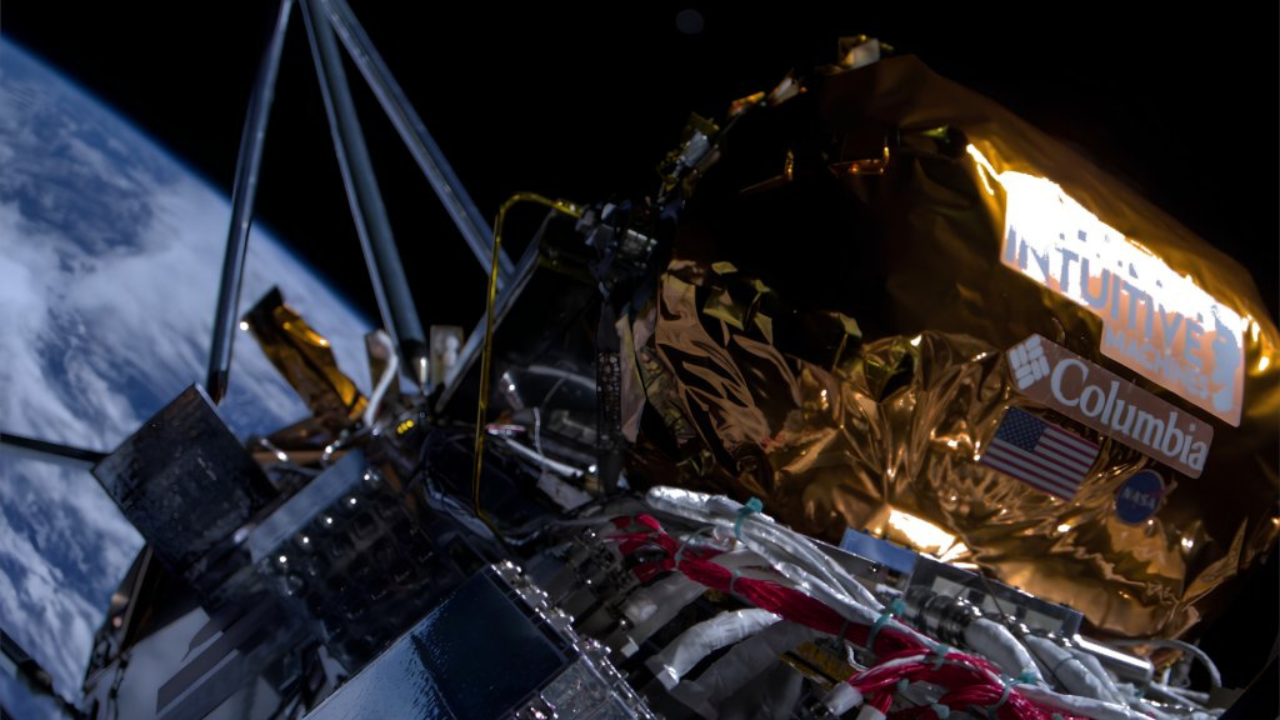
[ad_1]
NEW DELHI: Odysseus, the first US spacecraft to land on the Moon in half a century, was ‘still kicking’ on Thursday but nearing shutdown after an awkward sideways landing disrupted communications and affected its solar chargers. The spacecraft, which touched down on the lunar surface a week ago, had hoped to run for up to 10 days. However, its operators are now awaiting the final signals from the multi-million-dollar mission to collect data.
The fate of Odysseus will be determined by Intuitive Machines, the Texas-based company that Nasa paid $118 million to build and fly the robot lander.As of now, Odysseus is still operating, but flight controllers are monitoring the situation closely. They plan to download additional data and configure the lander to regain power from solar panels following a three-week hibernation during the frigid lunar night.
Shares of Intuitive Machines have seen a 3% decline on Thursday and have lost over a third of their value this week after the rough landing on February 22.
While Nasa has managed to extract some data from all six of its science payloads, it remains uncertain how much information has been lost by the agency and the six commercial payloads.
The Nova-C-class lander, which stands 13 feet (4 meters) tall, was launched on February 15 from Nasa’s Kennedy Space Center in Florida. It began orbiting the Moon six days later.
The issue with the sideways landing and the tilted position of Odysseus was caused by a navigational glitch. Intuitive Machines acknowledged that human error was to blame for neglecting to unlock a safety switch before launch, resulting in the vehicle’s range finders being disabled. The company had decided to skip a test-firing of the laser system during pre-launch checks, which led to the safety switch lapse.
As a consequence, two of the spacecraft’s communication antennae were knocked out of commission and its solar panels were facing the wrong direction. This limited Odysseus’ ability to recharge its batteries and prompted Intuitive Machines to anticipate losing contact with the spacecraft on Tuesday morning.
According to Nasa chief Bill Nelson, Odysseus landed beside a crater wall and is leaning at a 12-degree angle. However, it is unclear whether this angle is measured from the surface or an upright position.
Intuitive executives believe that Odysseus caught the foot of one of its landing legs on the lunar surface, causing it to tip over and come to rest horizontally. An image from an orbiting Nasa spacecraft revealed the lander as a tiny speck near its intended destination in the Moon’s south pole region.
Odysseus is not only the first US spacecraft to land on the Moon since Nasa’s last crewed Apollo mission in 1972 but also the first commercially manufactured and operated space vehicle to achieve a lunar landing. This milestone marks an important step in Nasa’s Artemis program, which aims to return astronauts to the Moon this decade.
To date, only four other countries – the former Soviet Union, China, India, and Japan – have achieved a successful Moon landing. However, the United States remains the only country to have sent humans to the lunar surface.
(With agency inputs)
The fate of Odysseus will be determined by Intuitive Machines, the Texas-based company that Nasa paid $118 million to build and fly the robot lander.As of now, Odysseus is still operating, but flight controllers are monitoring the situation closely. They plan to download additional data and configure the lander to regain power from solar panels following a three-week hibernation during the frigid lunar night.
Shares of Intuitive Machines have seen a 3% decline on Thursday and have lost over a third of their value this week after the rough landing on February 22.
While Nasa has managed to extract some data from all six of its science payloads, it remains uncertain how much information has been lost by the agency and the six commercial payloads.
The Nova-C-class lander, which stands 13 feet (4 meters) tall, was launched on February 15 from Nasa’s Kennedy Space Center in Florida. It began orbiting the Moon six days later.
The issue with the sideways landing and the tilted position of Odysseus was caused by a navigational glitch. Intuitive Machines acknowledged that human error was to blame for neglecting to unlock a safety switch before launch, resulting in the vehicle’s range finders being disabled. The company had decided to skip a test-firing of the laser system during pre-launch checks, which led to the safety switch lapse.
As a consequence, two of the spacecraft’s communication antennae were knocked out of commission and its solar panels were facing the wrong direction. This limited Odysseus’ ability to recharge its batteries and prompted Intuitive Machines to anticipate losing contact with the spacecraft on Tuesday morning.
According to Nasa chief Bill Nelson, Odysseus landed beside a crater wall and is leaning at a 12-degree angle. However, it is unclear whether this angle is measured from the surface or an upright position.
Intuitive executives believe that Odysseus caught the foot of one of its landing legs on the lunar surface, causing it to tip over and come to rest horizontally. An image from an orbiting Nasa spacecraft revealed the lander as a tiny speck near its intended destination in the Moon’s south pole region.
Odysseus is not only the first US spacecraft to land on the Moon since Nasa’s last crewed Apollo mission in 1972 but also the first commercially manufactured and operated space vehicle to achieve a lunar landing. This milestone marks an important step in Nasa’s Artemis program, which aims to return astronauts to the Moon this decade.
To date, only four other countries – the former Soviet Union, China, India, and Japan – have achieved a successful Moon landing. However, the United States remains the only country to have sent humans to the lunar surface.
(With agency inputs)
[ad_2]
Source link
